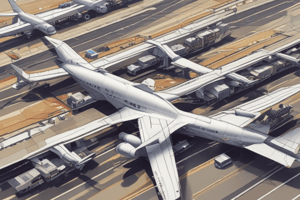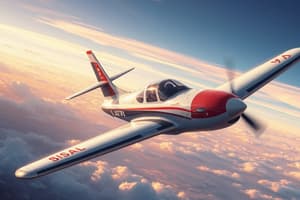Podcast
Questions and Answers
What is an aircraft?
What is an aircraft?
- A land vehicle
- A type of boat
- A device used for flight in the air (correct)
- A type of animal
What is an airplane?
What is an airplane?
An engine-driven fixed-wing aircraft heavier than air.
What characterizes a glider?
What characterizes a glider?
It is a heavier-than-air aircraft supported in flight by air against its lifting surfaces without relying on an engine.
What is a lighter-than-air aircraft?
What is a lighter-than-air aircraft?
What defines an airship?
What defines an airship?
How does a balloon sustain flight?
How does a balloon sustain flight?
What is powered-lift?
What is powered-lift?
What is a powered parachute?
What is a powered parachute?
Define a rocket.
Define a rocket.
What is a rotorcraft?
What is a rotorcraft?
What characterizes a gyroplane?
What characterizes a gyroplane?
How does a helicopter generate horizontal motion?
How does a helicopter generate horizontal motion?
What is weight-shift control?
What is weight-shift control?
Flashcards
Aircraft
Aircraft
Any device intended for flight in the air.
Airplane
Airplane
Engine-driven, fixed-wing, heavier-than-air aircraft supported by air dynamics against its wings.
Glider
Glider
Heavier-than-air aircraft that relies on air dynamics for lift, without primarily depending on an engine.
Lighter-than-Air Aircraft
Lighter-than-Air Aircraft
Signup and view all the flashcards
Airship
Airship
Signup and view all the flashcards
Balloon
Balloon
Signup and view all the flashcards
Powered-Lift Aircraft
Powered-Lift Aircraft
Signup and view all the flashcards
Powered Parachute
Powered Parachute
Signup and view all the flashcards
Rocket
Rocket
Signup and view all the flashcards
Rotorcraft
Rotorcraft
Signup and view all the flashcards
Gyroplane
Gyroplane
Signup and view all the flashcards
Helicopter
Helicopter
Signup and view all the flashcards
Weight-shift-Control Aircraft
Weight-shift-Control Aircraft
Signup and view all the flashcards
Study Notes
Aircraft Classification Overview
- Aircraft: Defined as any device intended for flight in the air (14 CFR 1.1).
Fixed-Wing Aircraft
-
Airplane: Engine-driven, fixed-wing, heavier-than-air aircraft supported by air dynamics against its wings.
-
Glider: Heavier-than-air aircraft that relies on air dynamics for lift, without primarily depending on an engine.
Lighter-than-Air Aircraft
-
Lighter-than-Air Aircraft: Capable of rising and sustaining flight using gases lighter than air. Includes airships and balloons.
-
Airship: An engine-driven lighter-than-air aircraft that can be steered; designed for controlled movement.
-
Balloon: A non-engine driven lighter-than-air aircraft that achieves flight through gas buoyancy or heating.
Powered Aircraft
-
Powered-Lift: Heavier-than-air aircraft with vertical takeoff and landing capabilities, relying on engine-driven lift devices for low-speed flight and traditional airfoils during horizontal flight.
-
Powered Parachute: Features a flexible or semi-rigid wing, not positioned for flight until in motion; contains engine and seats within the fuselage connected to landing gear.
Rocket and Rotorcraft
-
Rocket: Aircraft propelled by ejected gases from self-contained propellants, not reliant on outside air intake; includes all detachable parts during operation.
-
Rotorcraft: Heavier-than-air aircraft that gains lift primarily from rotor-generated support; categories include gyroplanes and helicopters.
Types of Rotorcraft
-
Gyroplane: A rotorcraft whose rotors are initially started by engine but rotate due to air movement during flight; uses conventional propulsion independent of the rotor system.
-
Helicopter: A rotorcraft that relies mainly on engine-driven rotors for horizontal motion.
Weight-Shift-Control Aircraft
- Weight-shift-Control: A powered aircraft with a pivoting wing, allowing control via pilot maneuvers to change center of gravity; relies on wing deformation for flight control rather than traditional surfaces.
Studying That Suits You
Use AI to generate personalized quizzes and flashcards to suit your learning preferences.




